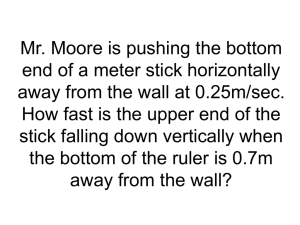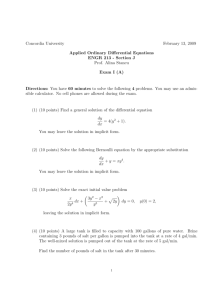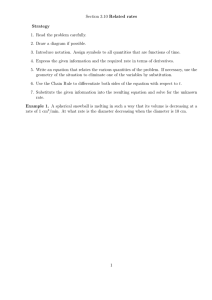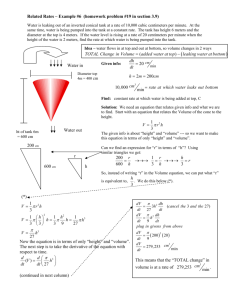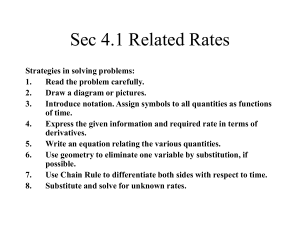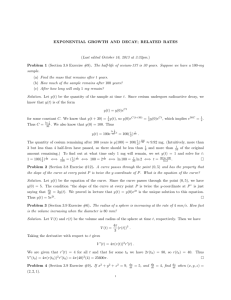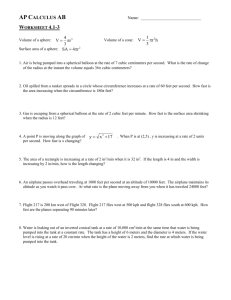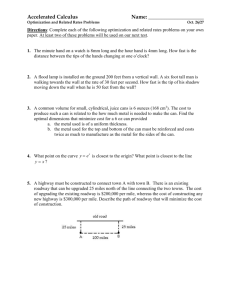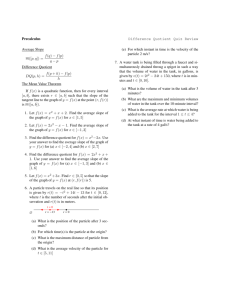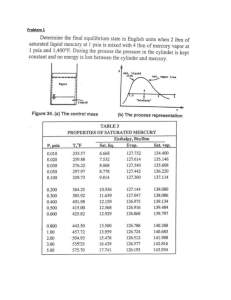Related rates.
advertisement
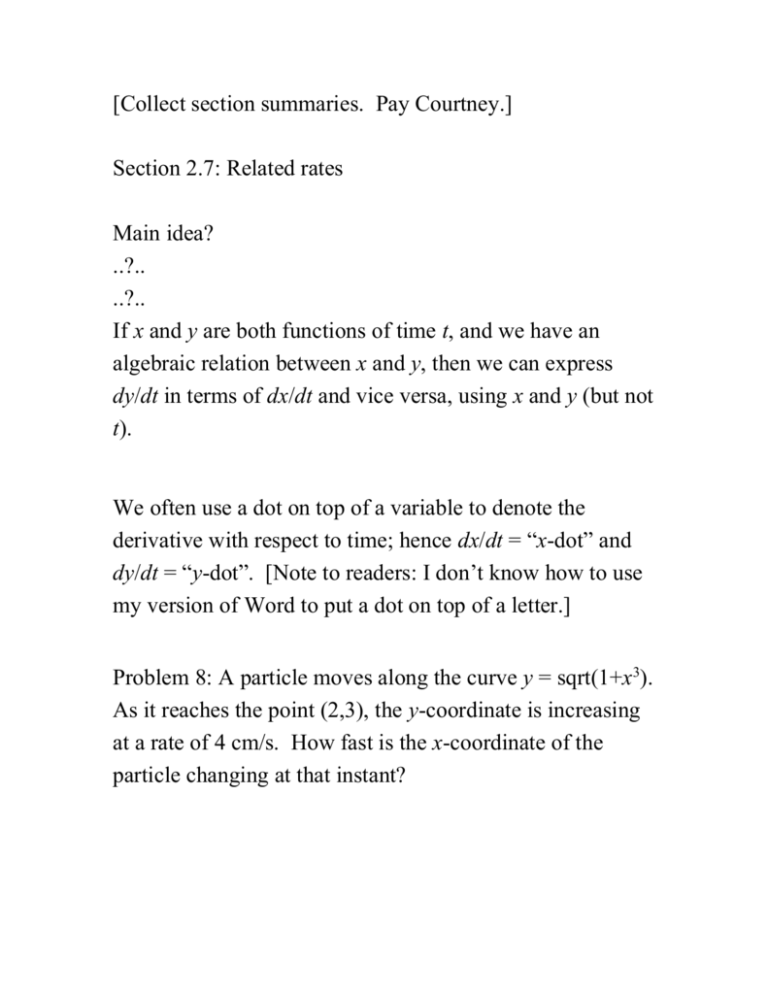
[Collect section summaries. Pay Courtney.] Section 2.7: Related rates Main idea? ..?.. ..?.. If x and y are both functions of time t, and we have an algebraic relation between x and y, then we can express dy/dt in terms of dx/dt and vice versa, using x and y (but not t). We often use a dot on top of a variable to denote the derivative with respect to time; hence dx/dt = “x-dot” and dy/dt = “y-dot”. [Note to readers: I don’t know how to use my version of Word to put a dot on top of a letter.] Problem 8: A particle moves along the curve y = sqrt(1+x3). As it reaches the point (2,3), the y-coordinate is increasing at a rate of 4 cm/s. How fast is the x-coordinate of the particle changing at that instant? Solution: y2 = 1 + x3 (that is, at all times t, we have [y(t)]2 = 1 + [x(t)]3), so (differentiating with respect to t) we get 2 y y-dot = 3x2 x-dot. Since we know y = 3 and y-dot = 4 and x = 2, we get x-dot = [2 y y-dot]/[3 x2] = [2(3)(4)]/[3(2)2] = 24/12 = 2 cm/s. Alternate solution: Use the fact that dy/dt = (dy/dx)(dx/dt) (this is just the Chain Rule) to write dx/dt as (dy/dt)/(dy/dx). We’re told dy/dt = 4 and we can compute dy/dx from the equation y = sqrt(1+x3) via the Chain Rule: dy/dx = [1/(2sqrt(1+x3))] [3x2], which at (2,3) gives dy/dx = [1/6] [12] = 2, so dx/dt = (dy/dt)/(dy/dx) = 4/2 = 2. Problem 14: A spotlight on the ground shines on a wall 12 m away. If a man 2 m tall walks from the spotlight toward the building at a speed of 1.6 m/s, how fast is the length of his shadow on the building decreasing when he is 4 m from the building? Solution: Let x be the man’s distance from the spotlight and y be the height of the man’s shadow. Draw similar right triangles to show that y/12 = 2/x. Hence y = 24/x = 24 x–1. So y-dot = (–24) x–2 x-dot = (–24) 8–2 (1.6) = –0.6 m/s, which means that the shadow is getting shorter at a rate of 0.6 m/s. Alternate solution: ... ..?.. ..?.. x y = 24, so x-dot y + x y-dot = 0, so y-dot = – (x-dot) y / x = – (1.6) (3) / 8 = –0.6 as before. Look one last time at a particle travelling on a circle. We have x2 + y2 = 1, so 2 x x-dot + 2 y y-dot = 0, y y-dot = – x x-dot, and y-dot / x-dot = – x / y = –1/(y/x). Problem 24: Water is leaking out of an inverted conical tank at a rate of 10,000 cm3 / min at the same time that water is being pumped into the tank at a constant rate. The tank has height 6 m and the diameter at the top is 4 m. If the water level is rising at a rate of 20 cm/min when the height of the water is 2 m, find the rate at which water is being pumped into the tank. Solution: … ..?.. ..?.. Let V(t) be the volume of water in the tank at time t, measured in cubic centimeters. If C = the rate at which water is pumped in, then dV/dt = C – 10,000. We have V = 1/3 r2 h, where V, r, and h all change with time. By similar triangles, r/2 = h/6, so r = h/3 and V = 1/3 (h/3)2 h = (/27) h3. Hence dV/dt = (/27) 3h2 (dh/dt) = (/9) h2 (dh/dt). When h = 2 m = 200 cm (don’t forget to pay attention to units!), dh/dt = 20 cm/min, so dV/dt = (/9) (200)2 (20) = 800,000/9, and C = dV/dT + 10,000 = 800,000/9 + 10,000 cm3 / min.


